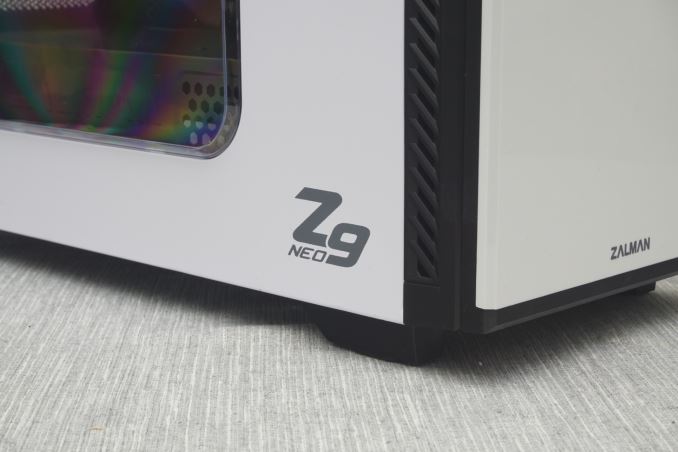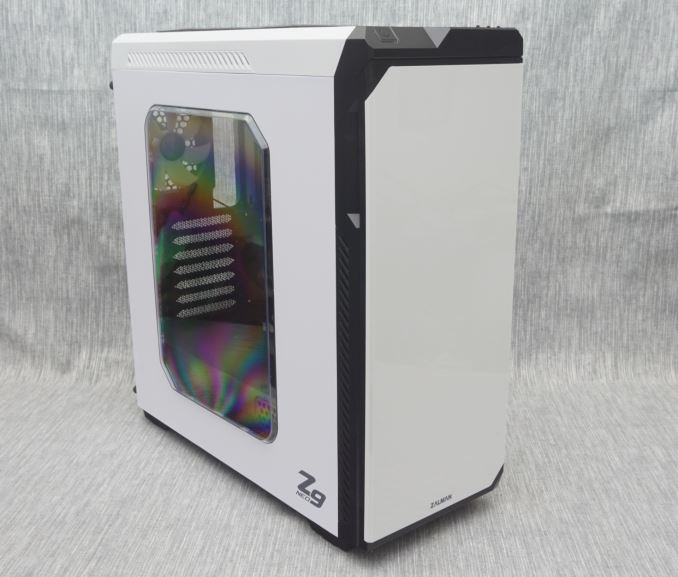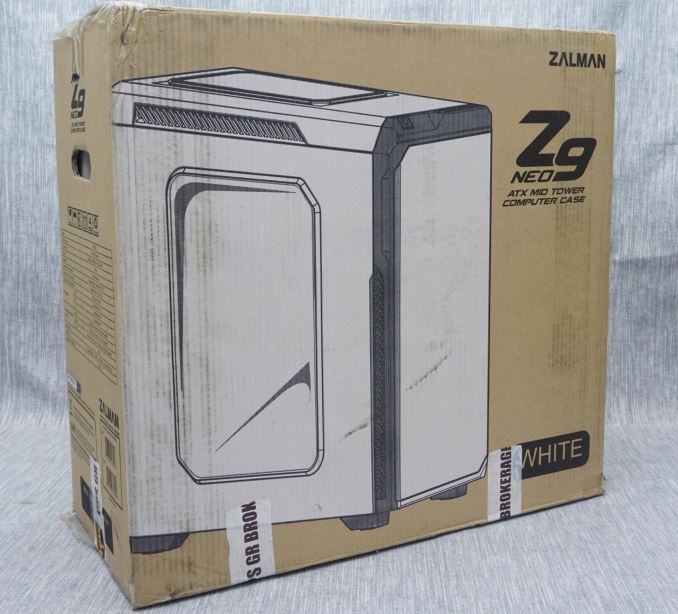The Zalman Z9 Neo Case Review
by E. Fylladitakis on May 20, 2016 9:00 AM EST- Posted in
- Cases/Cooling/PSUs
- Zalman
- ATX
- Case

Large and expensive computer cases are not for everyone. Actually, their market share is very limited, as many users seek the most cost-effective and practical hardware. Today we are having a look at Zalman’s latest case design, the Z9 Neo. The Z9 Neo is a case designed to provide high performance and versatility while preserving a very enticing price tag.
Introduction
Zalman is a well-known name in computing enthusiast's cycles, having provided advanced cooling solutions from 1999. During the last half decade, the company was diversifying into other segments of the consumer PC market, such as cases and power supplies, but the progress of the company slowed down after Moneaul's scandal in 2014. Zalman legally severed their ties with Moneaul and, despite that setback, is moving on as an independent company since then, releasing new products and diversifying into other segments of the PC market.
It took several months for Zalman to recover and start introducing new products, but it does look like the company is ready to established a firm foothold into the market once again: Zalman has introduced a number of new cases, coolers and gaming peripherals during the past several months. In this review we are having a close look on the Z9 Neo, one of their most popular recent case designs. On paper, the specifications of the Z9 Neo seem very impressive, especially for the case with a price tag lower than $80.
| Zalman Z9 Neo | ||
| Motherboard Size | ATX, Micro-ATX, Mini-ITX | |
| Drive Bays | External | 2 × 5.25" |
| Internal | 2 × 3.5"/2.5" (Drive's cage) 2 × 2.5" (Directly on the motherboard tray) 2 × 3.5"/2.5" (Into unoccupied 5.25" bays) |
|
| Cooling | Front | 2 × 120 mm or 2 x 140 mm (2 × 120 mm included) |
| Rear | 1 × 120 mm (included) | |
| Top | 2 × 120 mm (2 × 120 mm Blue LED fans included) | |
| HDD | - | |
| Bottom | - | |
| Radiator Support | Front | Up to 240 mm or 280 mm |
| Rear | Up to 120 mm | |
| Top | Up to 240 mm | |
| Side | - | |
| Bottom | - | |
| I/O Port | 2× USB 3.0, 2× USB 2.0, 1× Headphone, 1× Mic | |
| Power Supply Size | ATX | |
| Clearances | HSF | 160 mm |
| PSU | 180 mm | |
| GPU | 420 mm | |
| Dimensions | 490 mm × 205 mm × 482 mm 19.29 in × 8.07 in × 18.98 in |
|
| Prominent Features | · Optimized air flow cooling structure · Exclusive cooling for Power Supply · View through side smokey acrylic · Black cover sash · USB 3.0 Support & Convenient interface · Dust filter installed · Soundproof pad applied · Separable upper panel · Excellent expandability and wide space · Velcro & rubber type hole · Tool free HDD installation |
|
| Price | $73.40 | |
Packaging & Bundle
We received the Z9 Neo into a simple but sturdy brown cardboard box. The artwork is monochromic and based on a rough schematic of the case, with its basic specifications printed on the sides of the box. Although it is not much to gaze upon, the sturdy box and thick Styrofoam slabs provide adequate protection during shipping.
Zalman is trying to keep their products cost effective, so the very basic bundle was not a surprise for us. Only the basic mounting hardware, a few cable ties and a simple manual are being supplied alongside with the Z9 Neo.













30 Comments
View All Comments
Azethoth - Monday, May 23, 2016 - link
I still buy a big case so I can have a bunch of 200mm fans. Big and slow = quiet but good cooling. It is pretty empty in there these days though. Although 64gb of 2800 RAM sure made that empty feeling go away quickly once the lid closed.vpr - Sunday, May 29, 2016 - link
Pre-Note: I do not work for this company, just been following their progress a lot.The Kimera Industries Cerberus might be what you're looking for - http://www.kimeraindustries.com/#main-hero
They had a Kickstarter which failed, but that opened up some new opportunities. According to their forums which I've kept up with they're working out some final details before signing the paperwork and announcing the details as to what's happening next.
There's even talks of a possible ATX variant which looks incredibly small for what it offers.
The problem is part selection though more so than case selection. It's a chicken and egg problem though as power users don't support mATX because the options are lacking, yet manufactures don't put a lot of money into mATX because the power users aren't interested.
Impulses - Friday, May 20, 2016 - link
I'd argue that people jamming 4-5 drives into their case is faster than SLI at this point, yet every ATX case seems destined to have room for lots of drives...I'd love to see a slimmer ST Raven or Corsair Air 540 would, lose the drive cages but keep the straight airflow and room for enthusiast SLI/water configs.
There's still a lot of unexplored ATX form factors IMO.
erple2 - Friday, May 20, 2016 - link
I didn't realize that anyone made PCIe soundcard anymore, other than for some specialized applications, and sli/xfire hasn't really been worth the hassle IMO. Now that m.2 is pretty standard, I'm not sure what a PCIe SSD buys you anymore. I'd like a mATX case that didn't stink. My big storage is in another box attached via Ethernet, so having 5 drives in my case is too much hassle. mATX still has full features mobos (4 ram slots, at least two PCIe slots), so that's all the expandability that I need or want. And I expect that the vast majority of people agree. It pains me when people buy a giant Dell box in ATX size, using iGPU. I think I've said enough.Azethoth - Monday, May 23, 2016 - link
I grew up on sound cards in my builds. But 5 or 10 years ago I got two useless sound cards in a row. Turns out MS changed windows sound and made those guys obsolete. Then some new sound guys came out with high end cards and op amps, whatever that is etc. Lack of driver support made me finally spit on them and now I just enjoy the built in ROG sound on the MB.Azethoth - Monday, May 23, 2016 - link
Oh yeah, and who cares about sound cards when it's just a digital stream going straight to your computer's surround receiver. The new sound algorithms track individual sounds through the 3d geometry which kind of means sound belongs in the GPU anyways.Murloc - Saturday, May 21, 2016 - link
what's the point of SLI support if you're not using it?It's not something most people ever use anyway.
I've never owned a mobo bigger than mATX and I'm an average value-for-money gamer, and I didn't do it on purpose.
My case supports ATX motherboards but I don't need them when I'm aiming for the cheapest motherboard that has what I need (the chipset).
For a media PC I'd go with mITX.
PCIe SSDs are a rarity, PCIe sound cards are either for obscure use cases or for noobs, real speakers need an external amplifier anyway, and AVRs can get digital audio through HDMI and do processing themselves with Audissey and all that jazz, which a consumer sound card will never do (idk about specialized uses).
JoeyJoJo123 - Wednesday, May 25, 2016 - link
And for the average gaming PC build (which is the use-case most enthusiasts who bother to build a PC have) you see nothing more than a single GPU in the PCI-E slots, and usually less than 4 SATA drives.The usual difference between MicroATX and ATX is that one has 4 PCI-E slots and the latter has space for 5, 6, sometimes 7 slots, and ATX usually has ~2 more SATA ports, although it's still really common to find MicroATX boards these days with the standard 6 SATA ports.
You can still do Crossfire/SLI with a MicroATX.
You can still have an array of disks with MicroATX.
MiniITX's real problem is that most people don't understand the form factor and think it's a limitation rather than a freedom of case choice and additional form-factors and sizes. Additionally, for first-time builders, small MiniITX cases are incredibly difficult builds, due to stressful cable management issues, and the order you install items in the case actually REALLY matters, because otherwise, everything just won't go in right.
techxx - Sunday, May 22, 2016 - link
I think a lot of consumers are just uneducated on how legacy and obsolete ATX has been for the past few years. Like someone else said, I'd bet only 1-3% of consumers need anything more than ITX. SLI/Crossfire has never really been worth it and the needs for expansion cards is virtually non-existent.ninjaquick - Sunday, May 22, 2016 - link
I use 5 slots on my motherboard for legacy hardware, but otherwise agree that most users don't need larger than mATX. That said, it doesn't cost much more to build a low cost full atx case, and doing so widens the market a brand can reach, which is critical for the low margin low end.